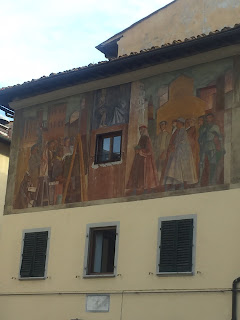Comanche Cyclists
I’ve just finished a superb book about the Comanche. The title is Empire of the Summer Moon and it’s written by a guy who lives in Austin, S.C. Gwynne. A few years ago, after a hunting trip out to Menard, TX (part of the old Comanche territory) I read a book about the Comanche and found them fascinating. This new book is even better: a history book that reads like a novel. One of the main learning points of the book was about how the white settlers and soldiers completely misunderstood the tribal ethic of the Comanche. To the whites, the Comanche seemed to be entirely barbaric, cruel, primitive, and godless. In fact, they were a nomadic warrior society that lived by supremely practical guidelines. They lived completely off the buffalo, and they were singularly focused on crushing success in battle over their foes (Spaniards, Mexicans, French, Texans, and other Indians -except the Kiowas- were all treated the same).
They terrorized their foes. The Comanche was one of only 2 plains tribes who actually fought mounted. He could shoot 20 arrows in the time it took a soldier to load and fire a musket once and he could hit a doorknob sized target 3 out of 5 times from 50 yards. The bows were so strong that it was not uncommon for an arrow to go through one buffalo and into another. He was also armed with a 14-foot lance and a large buffalo-hide shield that was capable of repelling most calibers of bullets.
Many tribes across this continent were sedentary, grew crops and established elaborate religious and civil organizations to govern their activities. Not the Comanche. They did have chiefs but rarely did any single chief exercise any unilateral power. Groups of men who went out and fought and raided were, in fact, recruited by their leaders, not coerced or ordered. It could be that no person in North America ever experienced more freedom on a human level than the Comanche male.
As I read the book and increased my understanding of the tribal dynamic, I couldn’t help thinking about how a cycling club (I’m talking bicycling here - I don’t know nuttin’ about no motorcycles) operates very tribally.
Our cycling group (Brazos Valley Cyclists) have all kinds of nice folks, but the core of the hardcore is the people who routinely are on the bike 200 miles or more a week. Another component of the group is the Texas A&M cycling team. Guys have gone on to professional cycling from this team. I’m also on the team, but that’s the subject of a future post.
For the cyclist, the bike is obviously of extreme importance – without the cycle there’s no cyclist. Your bike gets checked out by the other riders from the moment you show up. Similarly, the Comanche were completely transformed by the horse. What was previously a middling tribe became the absolute dominant force among the Plains Indians from the late 1700’s to the 1870’s because they got every possible advantage out of the horse.
The Comanche lived in an unforgiving environment where they had to not only survive the climate and lack of water but lethal raids from other tribes, settlers, and soldiers. So to stay with the tribe you needed to be able to help the tribe: steal horses, take scalps, defeat opponents in battle, and kill buffalo. In the cycling group, you are valued by how strong you are and what you can do for the group that is, ultimately, competitive with other college and club cycling teams.
The cycling group, therefore, is not a social organization the way the church choir or the book-of-the-month club is, and this turns some people off. I’m very sure a lot of people have shown up for one group ride and have never come back. We tend to go places where we are welcomed and affirmed. And until you earn your way into the bike tribe you may find that it doesn’t seem to be generally very friendly.
In our group a while back, one well-meaning person insisted that each person introduce themselves to the rest of the group before the 55-mile Saturday group ride. The suggestion was met with barely concealed scorn and disgust. Why? Just think about it in a tribal sense: “Hi, everybody! My name’s Buffalo Hump! I like archery and having my feet rubbed!” No. That dog won't hunt.
Like the real Comanche, the best ways to increase one’s status in the tribe is by a demonstration of personal bravery and a willingness to help the tribe. You take a good pull at the front and keep the wind off the other riders when nobody really feels like it. You show up to ride in bad conditions. And if you’re not out there just about all the time, you’ll get your tail kicked by the ones who are. Very infrequent riders are regarded by the tribe with distrust: like the white anthropologist showing up to take notes for an academic paper.
The whole vibe reminds me of a sign I saw once in a Special Operations headquarters near Brindisi, Italy: If you want a friend in this business, get a dog.


